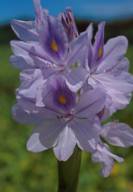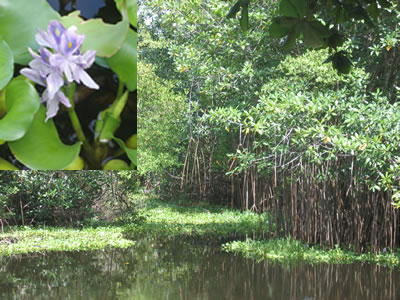Water hyacinth

Water hyacinth
Eichhornia crassipe
The name water hyacinth actually refers to seven different plant species of the genus Eichhorni. The name is however most commonly used for the species Eichhornia crassipe, the common water hyacinth which also is the species most frequently kept in aquariums.
All water hyacinth species are native to South- and Central America where they grow as free floating plants. Water hyacinths are usually quite small, about 25 cm / 10 inches high and 30-40 cm / 12-16 in across. They can however grow much larger than that and reach a height of almost 1 meter / 3.3 ft. The base of the plant is inflated giving it high buoyancy and making it float high in the water. The roots under the plant are pitch back to purplish black and usually appreciated as food by vegetable eating fish and apple snails. The roots also make excellent hiding place for fish fry.
The water hyacinth has been introduced to a lot of different waters across the globe and has turned into a problematic pest almost everywhere. Introduced water hyacinths can grow to cover entire bodies of water and threaten the native ecosystem. An example of this is Lake Victoria in Africa where the plant has caused a lot of problems by covering large areas of the lake, preventing sun light from penetrating down into the water. The lack of light has caused a significant decrease in the amount of algae in the lake and damaged the already fragile eco system of Lake Victoria. A lot of projects to keep the water hyacinth in check are currently being executed or planned in Lake Victoria and elsewhere. Examples of common solutions are to harvest the plants and use them as fertilizer or as fuel to make it economically interesting to fight the hyacinth. Another method involves the use of weevils species that eat water hyacinths. Introducing yet another species to an ecosystem is however always hazardous.
Another area with a large water hyacinth problem is Florida where the water hyacinth still constitutes a serious ecological threat even thought the situation has improved somewhat. When the situation was at its worst, an estimated 50 kilograms of water hyacinths could be found per square metre water in the waterways in Florida. Water hyacinth control is still needed in Florida to keep the population in check and to prevent it from overgrowing entire lakes where it would block sunlight and cause oxygen depletion. Other regions facing similar serious problems include Papua New Guinea and parts of Australia.
The secret of keeping water hyacinths in aquariums, besides having enough space above water, is light, light and more light because water hyacinth requires a lot of light to thrive and flower. Okay, I might oversimplify keeping water hyacinths a bit with that statement; they do need nutrients etc just like any other plant, but the fact remains that 90% of all failures related to keeping water hyacinths in aquariums are due to too little light. Another common reason for failing to keep water hyacinths is keeping them with fish that nibbles on and eat their roots. I would venture a guess that these two reasons alone account for more than 99% of all failed attempts of keeping water hyacinths in tropical aquariums. It is clearly shown by the problems it causes everywhere it goes in the wild that the water hyacinth is a very adaptable plant that can acclimatize itself to most waters as long as it gets enough light.
The water hyacinth is a very beautiful floating plant that is highly recommended to anyone that can keep it an open aquarium where it can grow and flower unrestrained.

Water hyacinths in Guatemala. Picture by: William
Fish News
Aquarium Forum
Calculators
Free Aquarium Ebook
Feedback
Fish Anatomy
Link to us
Photo gallery
Plant species
Tropical fish species
By Common name
By Scientific name
Tropical Marine fish
By Common name
By Scientific name
Algae Control
Aquarium Decoration
Aquarium Resources
Aquatic Plants
Barb Fish
Betta Fish
Breeding Fish
Catfish
Central American Cichlids
Cichlids
Clownfish
Corals
Corydoras Catfish
Discus Fish
Dwarf Cichlids
Fish Diseases
Frogs and Turtles
Goby Fish
Goldfish
Gourami
Invertebrates
Jellyfish
Killiefish
Lake Victoria Cichlids
Livebearers
Malawi Cichlids
Marine Aquariums
Marine Aquarium Fish
Other Fish
Pleco
Predatory Fish
Photography
Pond Fish
Responsible Fish Keeping
Rainbow Fish
Shark Fish
South American Cichlids
Tanganyika Cichlids
Tetra Fish
Tropical Fish Food
